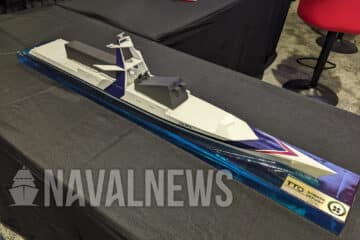The Turkish Defence Agency (SSB) announced the test firing with a video. In the video, the MARLIN and MIR USVs, developed by a partnership of Sefine Shipyard and Aselsan, are proceeding at high speed. The MIR USV fires two lightweight torpedoes (probably REXTORP – Recoverable Exercise Torpedo) from each tube after stopping.
While two USVs (MIR and MARLIN) were sailing at high speed, the SSB mentioned the joint use of two types of UPSs. This is because the MARLIN USV excels in anti-submarine warfare (ASW) capabilities. It participated in the REPMUS and Dynamic Messenger exercises for unmanned systems from NATO MARCOM and was praised by the NATO commanders who observed the exercise, according to Turkish media.

The torpedo-tube-equipped MIR was first observed during TCG Anadolu’s commissioning ceremony last week. The previous variant of the USV was introduced for its command and control capabilities in USV swarms, so, it was a surprise to see this surface drone with torpedo capabilities.

MIR’s ASW variant is capable to carry and launch NATO Standard lightweight torpedoes, including Mk44, Mk46, and Mk54. Roketsan’s ORKA lightweight torpedo is also expected to be fired from MIR after the torpedo is operational.
The torpedo launching system was developed by Aselsan with national means. It’s a fixed-mount,
lightweight torpedo launcher from the decks of surface vessels. The system can be integrated into the combat management systems, and launch NATO Standard LWTs using high-pressure air.
MIR USV – Not only a command & control vessel but also a submarine hunter

The MIR USV was unveiled in June 2022, with a USV swarm demonstration conducted in the Sea of Marmara by Aselsan. During the demonstration, MIR was spotted together with the Aselsan’s Albatros-S USVs in a swarm structure. “MIR” means “commander” in Turkish, and the ship’s long mast, which contains more than the usual sensors, reinforces the idea that MIR USV would assume a “control” role over the other USVs in the swarm.
On the other hand, different variants of MIR were presented by Sefine Shipyard in brochures during the DIMDEX 2022 exhibition held in Doha, Qatar, in March 2022. The USV was unveiled as an ASW variant of Sefine’s Constellation-class unmanned vessel, equipped with variable depth sonar (VDS) to meet endurance, sea state, and maneuverability requirements for defensive ASW operations in littoral waters. However, due to the boat’s flexibility to be configured according to the user’s needs, it appears to have additional roles in surface drone swarms.
With her hull design and propulsion system, MIR is capable of reaching speeds in excess of 36 knots and operating in sea state 4. According to the company brochure, there are some “important, surprising, and significant detection and capabilities” that can not be disclosed publicly.
Author’s comments
Fighting submarines is undoubtedly a risk for surface units. This is because, in general, underwater conditions are advantageous to the submarines, and when a surface ship wants to attack a submarine with torpedoes, it is already in the submarine’s torpedo danger zone. For this reason, naval air forces, such as ASW helicopters and maritime patrol aircraft (MPA), are used to detect and largely destroy submarines.
USVs deployed for ASW provide naval fleets with a second option to fight submarines without endangering the main combatants at sea. This is because no lives are risked when USVs are deployed in dangerous zones, and submarines are unlikely to engage these small units because of the limited minimum depth of some torpedoes or the limited amount of torpedoes the submarines have loaded.
Of course, the USV technologies around the world are still at the baby-steps level, and these capabilities will become more effective as appropriate CONOPS are developed and deployed in real-time operations, which will provide some feedback to marine companies to develop newer solutions to make them more effective.
With the 5 matured USV projects, the Turkish defence industry seems to pioneer in these technologies, and it would be interesting to observe further developments in unmanned systems.






